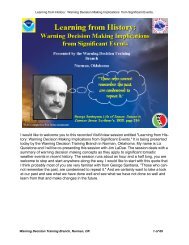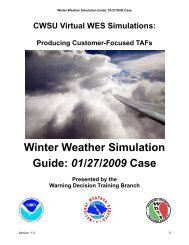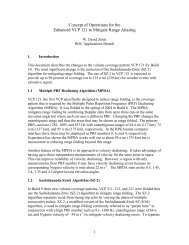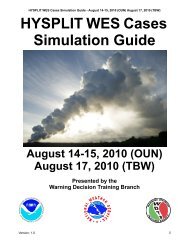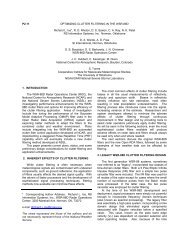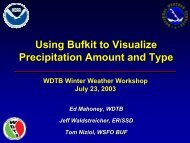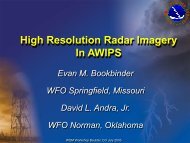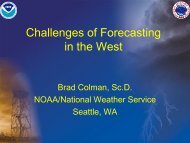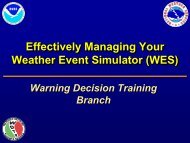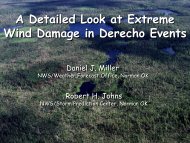Dual-Polarization Radar Data Guide
Dual-Polarization Radar Data Guide
Dual-Polarization Radar Data Guide
- No tags were found...
Create successful ePaper yourself
Turn your PDF publications into a flip-book with our unique Google optimized e-Paper software.
WDTB <strong>Dual</strong>-Pol Primer FY101. Introduction <strong>Dual</strong> <strong>Polarization</strong> Base ProductsJobsheet 1.3: Correlation Coefficient (CC)Objectives:• Gain a basic understanding of CC and how to properly visualize it in conjunction with reflectivityCase <strong>Data</strong>: 8 April 2008 nocturnal elevated supercell event in central Oklahoma.Instructions:1. Follow the steps 1-4 in Jobsheet 1.1 for loading D2D for the dual-pol primer jobsheets. Here arethe steps, in brief:a. Open a terminal window on your WESb. Change directory to the dual_pol primer case, i.e. cd /data/awips/dualpol_primerc. Start the launcher script, i.e. ./dualpol_primer.cshd. Type in 1.3 from the list of optionse. After ~1 minute, the new windows will close to be replaced by a “Start D-2D” window.f. Click ok in the “Start D-2D” window and the subsequent window that pops up.2. Open the procedure “<strong>Dual</strong>-pol Primer” and select the bundle “Jobsheet 1”. This will give youthese products loaded into the following 4-panel layout, as well as the ability to do environmentalsampling:1. 0.5 degree reflectivity (Z) paired with storm-relative mean radial velocity (SRM)2. 0.5 degree differential reflectivity (ZDR) paired with base mean radial velocity (V)3. 0.5 degree specific differential phase shift (KDP) paired with hydrometeor classification (HCA)4. 0.5 degree correlation coefficient (CC) with velocity spectrum width (SW)3. Navigate to the 0434 UTC volume scan, and turn on cursor sampling.4. Zoom into the storm located at about 10 degrees and 23 nm, in northern Oklahoma County. Thisis the same storm that we looked at in jobsheet 1.2.5. Examine the CC product in the lower right hand quadrant either in 4-panel mode or hit the #3 keyto enter Panel Combo/Rotate (PCR) mode and zoom into CC. Try both to see what you likebetter. Using the cursor sampling (and all-panel sampling) and panel-combo rotate functions,examine the CC values in the forward flank core of this supercell, roughly between ranges 22-26nm and azimuths 012-024 degrees.Question 1: What are the correlation coefficient (CC) values within this sample volume?Answer: Generally between 0.97 and 0.99, although there are some CC values of 0.90 and below on thewestern edge of the high ZDR values.Question 2: Considering only CC values, what can you say about the hydrometeors within thissample volume? Feel free to refer to the CC job aid.Answer: CC values between 0.95 and 1.00 indicate that there is a very low diversity of hydrometeorshapes, sizes, types and orientations.4
Question 3: Now consider the CC values in combination with the values of Z and ZDR in thissample volume. What do you think the most likely hydrometeor type is within this samplevolume? Feel free to refer to the CC job aid.Answer: Heavy rain via large drops.Discussion: ZDR values from +4.5 to +6 dB indicate that a large oblate spheroids are contained withinthis sample volume. CC values above 0.95 indicate a homogenous hydrometeor type, shape, phase, andsize. Both of these factors suggest large liquid hydrometeors make up this region of the storm. Given Zvalues from 48-55 dBZ, which indicate strong returned power, the most likely precipitation type is heavyrain.Now shift your focus to the CC values in the main core of this supercell, roughly between ranges24-29 nm and azimuths 003-010 degrees. This is the same sample volume where Z values aregenerally between 56-67 dBZ, and ZDR values are generally between +0.5 and +1.5 dBZ, as we sawin the job sheet exercise 1.1.Question 4: What are the correlation coefficient (CC) values within this sample volume?Answer: Generally between 0.85 and 0.95.Question 5: Considering only CC values, what can you say about the hydrometeors within thissample volume?Answer: CC values between 0.85 and 0.95 indicate that there is an increasing de-correlation betweenhorizontal and vertical returned power, and thus a significant increase in the diversity of hydrometeorshapes, sizes, types, and orientations within this sample volume. Thus the presence of multiplehydrometeor types, sizes, shapes, and orientations can be deduced from the decreased CC values.Question 6: Now consider the CC values in combination with the values of Z and ZDR in thissample volume. What do you think the most likely hydrometeor type is within this samplevolume? Feel free to use the job aids for ZDR and CC.Answer: Hail mixed with heavy rain.Discussion: High Z values from 56-67 dBZ strongly imply the presence of frozen and/or liquid-coatedfrozen hydrometeors, as purely heavy rainfall usually will not result in Z values above about 57 dBZ.However, when we combine these Z values with significantly lower CC values from 0.85 to 0.95, we knowthat we have a diversity of hydrometeors within the sample volume (i.e. raindrops and hailstones).Weakly positive ZDR values from +0.5 to +1.5 dB indicates that least some slightly oblate hydrometeorsare present. Hailstones (unless they are partly or completely covered with water) tend to be closer tospherical in shape or tumble as they fall, thus giving the appearance to the radar of a near meanspherical profile within the sample volume. The presence of oblate spheroid raindrops mixed with hail andlikely water coated hail makes the ZDR greater than 0, but the presence of the more spherical hailweights the ZDR much closer to 0 than in pure heavy rain. CC values > 0.90 support the presence of amixture of rain and hail, and probably not giant hail since the CC values in this rain and hail shaft are stillindicative of Rayleigh scattering, i.e. CC values below roughly 0.70 in hail cores tend to indicate giant(larger than golfballs) hail.5
Bonus Question 7: Review the 0.5 deg Z, ZDR, CC and KDP base data at 0434 UTC in theelongated hook echo portion of this supercell, roughly 20-22 nm range between azimuths 003-004degrees. Using what you have learned, what is your best estimate of hydrometeor type within thissample volume? (Refer to Training Aids for assistance)Answer: Z values are generally 50-55 dBZ, ZDR values are generally between +4 and +5.5 dBZ, CCvalues are generally 0.97-0.98 and KDP values are generally between 0.5 and 2.0 deg/km. Thiscombination of dual-pol base data is generally supportive of heavy rain with little or no hail present. CCvalues greater than 0.95 suggest a homogeneous hydrometeor type, and ZDR values above +4 dBZ andKDP values greater than 0.5 deg/km strongly support larger (greater than 3 mm diameter) droplet sizes,and lots of them given KDP as high as 2 deg/km. Finally, Z values from 50-55 dBZ suggest very intenserainfall rates provided the precipitation type is all liquid.Now use either the image toggle in 4 panel or Panel Combo/Rotate mode (hit the 8 key), to viewthe Hydrometeor Classification Algorithm (HCA) output for this storm at 0434 UTC. Compare theHCA output to the hydrometeor types we determined from our analysis of the dual-pol base data.Question 8: Does the HCA output agree with the most likely hydrometeor types deduced from thebase data analysis? Feel free to refer to the HCA training aid.Answer: In general, yes. The HCA depicts heavy rain in the forward flank core of the supercell, andmostly heavy rain in the hook echo region. The main precip core was tagged “RH” which is hail possiblymixed with rain, agreeing with the HCA. You will notice that in many parts of the supercell, where clearlythere is precipitation, the HCA tags many bins incorrectly as “biological”.8
WDTB <strong>Dual</strong>-Pol Primer FY102. Warm Season <strong>Dual</strong>-Pol <strong>Radar</strong> SignaturesJobsheet 2.1: ZDR ColumnsIntroduction:Objectives:• Identify a “ZDR column” signature in dual-pol radar base data, and understand its significance indetermining the updraft core location and relative updraft strength• Gain experience in integrating all dual-pol base products with each other, reflectivity, and in termsof location relative to temperature levels.Case <strong>Data</strong>: 8 April 2008 nocturnal elevated supercell event in central Oklahoma.Instructions:1. Follow the steps 1-4 in Jobsheet 1.1 for loading D2D for the dual-pol primer jobsheets. Here arethe steps, in brief:a. Open a terminal window on your WESb. Change directory to the dual_pol primer case, i.e. cd /data/awips/dualpol_primerc. Start the launcher script, i.e. ./dualpol_primer.cshd. Type in 2.1 from the list of optionse. After ~1 minute, the new windows will close to be replaced by a “Start D-2D” window.f. Click ok in the “Start D-2D” window and the subsequent window that pops up.2. Open the procedure “<strong>Dual</strong>-pol Primer” and select the bundle “Jobsheet 2.1”. This will give youthese products loaded into the following 4-panel layout, as well as the ability to do environmentalsampling:1. All-Tilts reflectivity (Z) paired with storm-relative mean radial velocity (SRM)2. All-Tilts differential reflectivity (ZDR) paired with base mean radial velocity (V)3. All-Tilts specific differential phase shift (KDP) paired with hydrometeor classification (HCA)4. All-Tilts correlation coefficient (CC) with velocity spectrum width (SW)3. Navigate to the 0.5 degree elevation slice of the 0513 UTC volume scan.4. Find your way to the storm in central Kingfisher County, which is located at AZ/RAN 332/49 nm.5. Using the up and down arrows in all tilts, move up and down through the elevation slices between0.5 and 8.0 degrees to gain a general feel for the 3D reflectivity structure of this storm.Focus on the ZDR product in the upper right panel, and navigate to the 1.8 degree elevation slice.Using cursor sampling, examine the ZDR values in the strong reflectivity core (greater than 50dBZ), using the 4 panel layout or entering Panel Combo/Rotate (PCR) mode and toggling between#1 and 2.Question 1: In a general sense, what are the ZDR values within the 50+ dBZ reflectivity core on the1.8 deg tilt? What are the maximum values in this area?Answer: In much of the 50+ dBZ Z core, ZDR values are generally between +0.6 and +1.0 dBZ, with aminimum of +0.24 at AZ/RAN 332/49. However, you will note that there is a distinct (but relatively small)area of considerably higher ZDR values co-located with the far southwest flank of the 50+ dBZ Z corewhere ZDR values are on the order of +1.5 to +2.5 dBZ, with a maximum of +3.4 dBZ at AZ/RAN 329/49.9
cross section. Play around with FSI in this storm, toggling between Z, ZDR, KDP, and CC for theZDR column, getting a feel for FSI and the characteristics of the ZDR column.Summary: The environmental freezing level during this event was between 11,000 and 11,500 feet agl.So the radar beam is sampling this storm near the freezing level at 1.8 degrees (~11,000 feet agl) andwell above the ambient freezing level at the 2.4 (~14,500 feet AGL), 3.1 (~18,100 feet AGL), and 4.0(~23,000 feet AGL) degree elevation slices.The signature that we have examined in this job sheet is known as a “ZDR column” since it basicallyconsists of a narrow column of higher ZDR values that extend to well above the environmental freezinglevel in a thunderstorm, indicating the presence of liquid hydrometeors well above the freezing level.There is also often a nearby and/or co-located signature in the KDP data likewise indicating the presenceof liquid water. ZDR column signature is associated with rising convective-scale motion. In weakerupdrafts the ZDR column can identify the location of the updraft. In sheared storms that have muchstrong updrafts, typically the larger drops (that produce the signature) are found on the flanks of theupdraft, with the core having much smaller drops and thus lower ZDR and KDP. Generally, as updraftsincrease in intensity, liquid water could extend higher, and thus a ZDR column will also extend higheraloft. The ZDR column in this storm in Kingfisher County is quite strong, and indicates the presence ofliquid drops 12,000 to 13,000 feet above the environmental freezing level.ZDR columns and elevated regions of KDP are nice to look at with cross sections, and FSI shows bothsignatures very well. Using FSI, you can gauge how deep the enhanced ZDR values are, as well as howhigh the ZDR values are. The deeper and stronger (more positive) the ZDR values are, in theory thestronger the updraft. Eventually, studies will be done that look at height and strength of the ZDR columnvs. severe weather reports at the surface, and perhaps even dual-doppler studies relating them to actualupdraft velocity. For now, you can compare storms’ ZDR columns in the same environment to see whichone might have a stronger updraft. In a rough sense, + ZDR greater than +1.5 dB extending at least 10kft above the environmental freezing level signifies an “impressive” updraft, associated with supercellsproducing severe weather.11
WDTB <strong>Dual</strong>-Pol Primer FY102. Warm Season <strong>Dual</strong>-Pol <strong>Radar</strong> SignaturesJobsheet 2.2: ZDR Columns and Splitting SupercellsObjectives:• Identify ZDR columns associated with a storm in the process of splitting• Gain experience in integrating all dual-pol base products with each other, reflectivity, and in termsof location relative to temperature levels.Case <strong>Data</strong>: 8 April 2008 nocturnal elevated supercell event in central Oklahoma.Instructions:1. Follow the steps 1-4 in Jobsheet 1.1 for loading D2D for the dual-pol primer jobsheets. Here arethe steps, in brief:a. Open a terminal window on your WESb. Change directory to the dual_pol primer case, i.e. cd /data/awips/dualpol_primerc. Start the launcher script, i.e. ./dualpol_primer.cshd. Type in 2.2 from the list of optionse. After ~1 minute, the new windows will close to be replaced by a “Start D-2D” window.f. Click ok in the “Start D-2D” window and the subsequent window that pops up.2. Open the procedure “<strong>Dual</strong>-pol Primer” and select the bundle “Jobsheet 2.2”. This will give youthese products loaded into the following 4-panel layout, as well as the ability to do environmentalsampling:1. All-Tilts reflectivity (Z) paired with storm-relative mean radial velocity (SRM)2. All-Tilts differential reflectivity (ZDR) paired with base mean radial velocity (V)3. All-Tilts specific differential phase shift (KDP) paired with hydrometeor classification (HCA)4. All-Tilts correlation coefficient (CC) with velocity spectrum width (SW)3. Navigate to the 0.5 degree elevation slice of the 0434 UTC volume scan.4. Find your way to the storm in extreme southwest Kingfisher County, which is located at AZ/RAN315/50 nm.5. Using the up and down arrows in all tilts, move up and down through the elevation slices between0.5 and 8.0 degrees and backwards/forwards in time to gain a general feel for the 3D reflectivitystructure of this storm.Focus on the ZDR product in the upper right panel (or #2 key in Panel Combo/Rotate (PCR) mode),and navigate to the 2.4 degree elevation slice. Using cursor sampling, examine the areas ofenhanced ZDR (+1.5 dB and higher).Question 1: Check/toggle ZDR with reflectivity at 2.4 degrees on the 0434 UTC scan. Identify theAZ/RAN of the regions of enhanced ZDR that have sufficient reflectivity returns such that dataquality is probably not in question (Hint: Avoid edges of storms and Z less than ~15 dBZ)?Answer: One such region is 311/50 nm and another is at 316-317/54 nm. Both regions have enhanced (>1.5 dB) ZDR values on adjacent radials within adequate reflectivity. Another region is located 319/42 nm,but is in much weaker reflectivity further southwest. This one could be a new updraft developing to theSW of the storm. We’ll want to check height continuity…which by design is the next step!Question 2: Examine the height continuity of the features you identified in question 1. Check forcontinuity from 0.5 degree up until a tilt where you can no longer see the feature. List the relative12
location (relative to the core of reflectivity, i.e. “North of the main core of reflectivity”) of the ZDRfeature, and how high each one extends (MSL) at 0434 UTC. Optional: Feel free to use FSI tocheck out these features as well. FSI is an ideal tool for this kind of analysis!Answer: AZ/RAN 311/50 nm: Has excellent height continuity, decent time continuity, extends to 15.8 kftMSL, and is located on the inflow side of this storm (southwest edge for a right mover).AZ/RAN 317/54 nm: Has excellent height and time continuity, extends to perhaps 20.5 kft MSL (3.1 degtilt, could make an argument that it goes to 4.0 deg), and is located along the reflectivity gradient north ofthe main precipitation core.AZ/RAN 319/42 nm: Has decent height continuity, not much time continuity (though that may be becauseit is a new updraft), extends to 13 kft MSL, and generally is in much weaker reflectivity far removed fromthe main precipitation core. Overall, this feature is less impressive than the other two, both in height andstrength, and in terms of where it is located relative to the precipitation core.Question 3: Now examine KDP at 2.4 degrees (Key #4 in PCR mode). What are the characteristicsof KDP in the vicinity of the ZDR columns you identified in question 2?Answer: With the enhanced ZDR at 319/42 nm, there is no positive KDP anywhere near the max in ZDR,including in the lowest tilts. With the other two ZDR columns, in both cases, the maximum in KDP isoffset from the maximum in ZDR. The area of enhanced KDP in relatively lower ZDR means there areprobably a much higher quantity of liquid drops, but the mean size is smaller than in the maximum ZDRareas. Drop size sorting and/or drop shedding from wet hail could be to blame for the enhanced KDPsignature and thus the higher concentration of smaller drops.Question 4: Now examine CC at 2.4 degrees (Key #3 in PCR mode). What are the characteristicsof CC in the vicinity of the ZDR columns you identified in question 3.Answer: Again, the ZDR column/maximum to the southeast of the main precip core does not show anydecrease in CC. The other two ZDR columns to the southwest and north of the precip core each havereduced CC. Follow the enhanced ZDR values from one maximum to the other and you’ll notice that CCis around 0.95 throughout this region. The lowest CC is associated with the northern maximum, droppledwell below 0.90. You’d expect reduced CC well above the environmental freezing level in an updraftbecause the liquid should be in the process of freezing, leading to a diversity of hydrometeors. With ZDRcolumns, CC will be very high (> 0.97) when the primary precipitation type of liquid, then lower in thetransition phase (< 0.95), then very high again further aloft associated with a transition to all frozen precip.The exception would be very large hail aloft, which will reduce CC below 0.95.Summary: This jobsheet, though short on questions, did contain a good deal of “go at your own paceanalysis”. This was by design since you already took a baby steps approach to ZDR columns. The pointof this jobsheet was to hone your skills looking for ZDR columns and to envision a scenario in whichfinding ZDR columns would be beneficial to warning lead time and accuracy. Hopefully you were able toidentify 2 primary ZDR columns associated with the main precipitation core; one to the north and theother to the southwest. You might have noticed that at this point (0434 UTC) there appeared to be justone primary precipitation core. Clearly an updraft exists on the north side of the storm given the strongZDR column signature. Assuming as a warning forecaster you checked to make sure the storm wasrotating and moving to the right of the mean flow, you could make inferences about what the ZDRcolumns mean. The one to the southwest is associated with the right mover’s updraft, while the one tothe north is probably associated with a developing left mover. It’s in an ideal location to be associatedwith a left mover updraft. In fact, if you could look 15 minute into the future (can’t given the currentWES/jobsheet setup), you’d see that this storm splits and has separate low-level precipitation cores bythe 0448 UTC scan. Identifying ZDR columns, in this example of a splitting supercell, could allow formuch better lead time on a warning or update for the left split.13
WDTB <strong>Dual</strong>-Pol Primer FY102. Warm Season <strong>Dual</strong>-Pol <strong>Radar</strong> SignaturesJobsheet 2.3: Hail DetectionObjectives:• Identify dual-pol radar signatures associated with hail• Gain experience in integrating all dual-pol base products with each other, reflectivity, and in termsof location relative to temperature levels.Case <strong>Data</strong>: 8 April 2008 nocturnal elevated supercell event in central Oklahoma.Instructions:1. Follow the steps 1-4 in Jobsheet 1.1 for loading D2D for the dual-pol primer jobsheets. Here arethe steps, in brief:a. Open a terminal window on your WESb. Change directory to the dual_pol primer case, i.e. cd /data/awips/dualpol_primerc. Start the launcher script, i.e. ./dualpol_primer.cshd. Type in 2.3 from the list of optionse. After ~1 minute, the new windows will close to be replaced by a “Start D-2D” window.f. Click ok in the “Start D-2D” window and the subsequent window that pops up.2. Open the procedure “<strong>Dual</strong>-pol Primer” and select the bundle “Jobsheet 2.3”. This will give youthese products loaded into the following 4-panel layout, as well as the ability to do environmentalsampling:1. All-Tilts reflectivity (Z) paired with storm-relative mean radial velocity (SRM)2. All-Tilts differential reflectivity (ZDR) paired with base mean radial velocity (V)3. All-Tilts specific differential phase shift (KDP) paired with hydrometeor classification (HCA)4. All-Tilts correlation coefficient (CC) with velocity spectrum width (SW)3. Navigate to the 0.5 degree elevation slice of the 0518 UTC volume scan.4. Find your way to the storm in western Lincoln County, which is located at AZ/RAN 039/32 nm.5. Using the up and down arrows in all tilts, move up and down through the elevation slices between0.5 and 8.0 degrees and backwards/forwards in time to gain a general feel for the 3D reflectivitystructure of this storm.6. For this jobsheet…IGNORE the data along the 036 degree azimuth. Blockage preventsusable/reliable dual-pol data.Question 1: In the reflectivity core of greater than 60 dBZ on the 0518 UTC scan, what are thevalues of ZDR on the following tilts?Answer: 0.5 deg (3.7 kft): -0.2 to +1.3 dB in the heart of the high Z core1.8 deg (8 kft): -0.2 to +0.8 dB4.0 deg (15 kft): -0.8 to +1.8 dB6.4 deg (24.4 kft):+0.5 to +1.1 dBQuestion 2: Given the ZDR values recorded in Question 1, what does that say about the medianshapes/orientations of the hydrometeors in the high reflectivity core? (Feel free to use the trainingaids)14
Answer: They are likely nearly spherical given the low ZDR. Because ZDR is dependent on D 6 (diameterof the scatterer to the 6 th ), large hydrometeors will strongly bias the signal. That’s why hail andspecifically large hail, which tumbles as it falls and is generally spherical, will tend to bias ZDR towardszero, even in the presence of rain. Small hail that falls with large rain drops or is coated with water is anexception, often leading to values of ZDR greater than 2 dB. For severe sized hail, look for low ZDR lessthan ~ +1 dB and high reflectivity.Question 3: In the reflectivity core of greater than 60 dBZ on the 0518 UTC scan, what are thevalues of CC on the following tilts?Answer: 0.5 deg (3.7 kft): 0.92-0.951.8 deg (8 kft): 0.88-0.98, lowest on west side of core4.0 deg (15 kft): 0.88 to 0.98, lowest on west side of core6.4 deg (24.4 kft): 0.99 throughoutQuestion 4: Given the CC values recorded in Question 3, what does that say about the probablebulk hydrometeor properties of this high reflectivity core? (Feel free to use the training aids)Answer: The 6.4 degree tilt is around the environmental -30 degC level, and given very high CC, it is clearthat the precip type, size, shape, and orientations do not change much in the hail core at that height. It’slikely all the hydrometeors are frozen completely and nearly spherical (given the ZDR) at this height andabove in the high reflectivity core. At 4.0 deg, the high reflectivity is in the region for potential hail growth(~ -10 degC). Values in hail should be 0.95 and less; this is particularly true on the west side of the core,when values lower than 0.90 indicate the presence of rain/hail mixture and perhaps a wet growth area.The same is true at 1.8 deg tilt. At the lowest tilt, values are generally around 0.93-0.95, also in the rangefor hail. Because values are on the higher end of CC for hail, it’s not likely that the hail is giant or oddlyshaped close to the surface.Question 5: In the reflectivity core of greater than 60 dBZ on the 0518 UTC scan, what are thevalues of KDP on the following tilts?Answer: 0.5 deg (3.7 kft): 3-8.8 deg/km. About as high as it ever gets1.8 deg (8 kft): varies a lot from slightly negative to +4 deg/km4.0 deg (15 kft): -1.2 deg/km to +1.2 deg/km, though most values around +0.4 deg/km6.4 deg (24.4 kft): ~0 deg/kmQuestion 6: Given the KDP values recorded in Question 5, what does that say about the presenceof rain in this high reflectivity core? (Feel free to use the training aids)Answer: Within the high reflectivity/low ZDR core, if there is significant KDP (0.5 or greater), then there isa good deal of liquid as well in those regions of overlap. In this example, there is likely a LOT of liquidwater mixed with the hail given the very high KDP closest to the surface. We do know that hail is presenttoo given the high reflectivity, low ZDR (~0 many cases), and lower CC (0.93-0.95). The further aloft youget, particularly above the environmental 0 C level, KDP is reduced, indicating a lack of liquid drops(though supercooled drops could easily exist, since they are very small and spherical they don’t have aKDP signature). The largest hail of the day fell at 0515 from the main part of this hail core, golfball indiameter. For the really large hail on the lowest tilts below the 0C level (roughly golfball and larger) thatdo not fall with much rain, you’d see ~0 ZDR, lower CC (> 0.90), and low KDP (< 1.0 deg/km), coincidentwith high reflectivity. For the data we’ve provided you in this primer, there were no examples of hail notmixed with a lot of rain. The hail detection process begins with checking high reflectivity, then look forZDR values less than 1 dB. Next check out CC to determine if the hail is giant or not, and if it is likely tobe mixed with rain. If KDP is also quite high in the high reflectivity/low ZDR core, the hail is likely watercoated and falling with rain.15
WDTB <strong>Dual</strong>-Pol Primer FY102. Warm Season <strong>Dual</strong>-Pol <strong>Radar</strong> SignaturesJobsheet 2.4: Three-Body Scatter SpikeObjective: To gain a greater understanding of three-body scatter spike signatures in dual-pol radar basedata.Case <strong>Data</strong>: 8 April 2008 nocturnal elevated supercell event in central Oklahoma.Instructions:1. Follow the steps 1-4 in Jobsheet 1.1 for loading D2D for the dual-pol primer jobsheets. Here arethe steps, in brief:a. Open a terminal window on your WESb. Change directory to the dual_pol primer case, i.e. cd /data/awips/dualpol_primerc. Start the launcher script, i.e. ./dualpol_primer.cshd. Type in 2.4 from the list of optionse. After ~1 minute, the new windows will close to be replaced by a “Start D-2D” window.f. Click ok in the “Start D-2D” window and the subsequent window that pops up..2. Open the procedure “<strong>Dual</strong>-pol Primer” and select the bundle “Jobsheet 2.4”. This will give youthese products loaded into the following 4-panel layout, as well as the ability to do environmentalsampling:1. All-Tilts reflectivity (Z) paired with storm-relative mean radial velocity (SRM)2. All-Tilts differential reflectivity (ZDR) paired with base mean radial velocity (V)3. All-Tilts specific differential phase shift (KDP) paired with hydrometeor classification (HCA)4. All-Tilts correlation coefficient (CC) with velocity spectrum width (SW)3. Navigate to the 0.5 degree elevation slice of the 0513 UTC volume scan.4. Find your way to the storm in Kingfisher County, which is located at AZ/RAN 332/50 nm.5. Using the up and down arrows in all tilts, move up and down through the elevation slices between0.5 and 8.0 degrees and backwards/forwards in time to gain a general feel for the 3D reflectivitystructure of this storm.Prior to answering the following questions, first ensure you are focused on the 0513 UTC volumescan.Question 1: Looking at only All-Tilts reflectivity data at 0513 UTC, is a three-body scatter spikeevident? If so, at which elevation angle(s)?Answer: Yes. A three-body scatter spike is fairly evident at the 1.8 and 2.4 degree elevation angles.However, there is at least some evidence of three-body scattering at all elevation slices below 1.8degrees and subtle evidence of three-body scattering at the 3.1 and 4.0 degree elevation slices in thereflectivity data.Now scan up and down through the elevation slices again, but this time look at both reflectivityand correlation coefficient base products, either using 4-panel or Panel Combo/Rotate (PCR).Question 2: In the 1.8 and 2.4 degree elevation angles, what are the CC values in the three-bodyscatter spike?16
Answer: Generally between 0.25 and 0.47.Question 3: What do these values of CC tell us? Feel free to use the training aids.Answer: CC values below 0.50 indicate significant de-correlation between horizontal and vertical returnedpower, and values this low normally indicate non-meteorological echoes.If you consider the three way scattering of power that occurs to create a three-body scatter spike, itshould be no surprise that CC is significantly reduced in TBSSs: 1. TBSSs have weak signal to noiseratios, thus CC will be suspect and more importantly 2. Scattering from a hail core, from the ground, andback to the hail core ensures significant de-correlation between how the horizontal and vertical powersbehave.Now use the up and down arrows in all-tilts to scan up and down through all elevation angles ofthis storm between 0.5 and 8.0 degrees. Examine the CC values down-radial from the strong Zcore > 60 dBZ in the area where you would expect three-body scattering to occur.Question 4: At elevation slices at and below 4.0 degrees, what is evident in the CC data?Answer: A distinct area of very low CC values is evident at all elevation slices between 0.5 degrees and4.0 degrees in the location where a TBSS would be expected down-radial from the strong Z core. CCvalues at all elevation slices within the TBSS are generally between 0.2 and 0.5. Perhaps even moreimportantly…notice that the CC values start to decrease significantly downradial of the hail core but stillwithin significant reflectivity (i.e. 20-40 dBZ). Normally, TBSSs were impossible to discern whensignificant reflectivity existed down-radial of the high Z core. This example, and others like it, show thepotential to find TBSSs even with significant down-radial reflectivity. Below is another TBSS. Focus onthe area inside the white blob. Notice how the TBSS in CC extends into 20-40 dBZ echo down-radial ofthe hail core.Question 5: How does the CC data help you in determining the presence or absence of three-bodyscattering at the elevation slices where Z data alone does not provide high confidence?Answer: The very low CC values at the 0.5, 0.9, 1.3, 3.1 and 4.0 degree elevation angles reveal with highconfidence that three-body scattering is occurring with this storm at those elevation angles. At the lowest3 elevation angles, weak echoes down-radial from the storm somewhat mask the presence of the TBSSin the reflectivity data, and at the 3.1 and 4.0 degree elevation angles the weak echoes down-radial from17
the strong Z core could easily be interpreted as being part of the main storm echo. However, the strongde-correlation evident in the CC data confirms the presence of three-body scattering at all of theseelevation angles.Summary: Severe de-correlation and CC values below 0.5 are common in three-body scatter spikes. CCdata is very useful in revealing areas of three-body scattering that would normally be masked inreflectivity data by meteorological echoes down-radial from the hail cores.18
WDTB <strong>Dual</strong>-Pol Primer FY102. Warm Season <strong>Dual</strong>-Pol <strong>Radar</strong> SignaturesIC2.5: Intense Rainfall RatesObjectives: Identify the dual-pol base data signature for intense and/or tropical rainfall rates.Case <strong>Data</strong>: 19 August 2007 Tropical Storm Erin re-intensification in central OklahomaInstructions:1. Follow the steps 1-4 in Jobsheet 1.1 for loading D2D for the dual-pol primer jobsheets. Here arethe steps, in brief:a. Open a terminal window on your WESb. Change directory to the dual_pol primer case, i.e. cd /data/awips/dualpol_primerc. Start the launcher script, i.e. ./dualpol_primer.cshd. Type in 2.5 from the list of optionse. After ~1 minute, the new windows will close to be replaced by a “Start D-2D” window.f. Click ok in the “Start D-2D” window and the subsequent window that pops up.2. Open the procedure “<strong>Dual</strong>-pol Primer” and select the bundle “Jobsheet 2.5”. This will give youthese products loaded into the following 4-panel layout, as well as the ability to do environmentalsampling:1. 0.5 deg reflectivity (Z) paired with storm-relative mean radial velocity (SRM)2. 0.5 deg differential reflectivity (ZDR) paired with base mean radial velocity (V)3. 0.5 deg specific differential phase shift (KDP) paired with hydrometeor classification (HCA)4. 0.5 deg correlation coefficient (CC) with Instantaneous <strong>Dual</strong>-Pol Precip Rate (DPR)3. Navigate to the 1004 UTC volume scan.4. Zoom in as far as you can, centering on Kingfisher County, northwest of the KOUN radar at theapproximate AZ/RAN 332/47 nm.Question 1: First, examine the Z data in central Kingfisher County. What Z values are apparent inthe area near AZ/RAN 332/47?Answer: 46 to 50 dBZQuestion 2: What are ZDR values at this same location?Answer: +0.8 to +1.5 dBQuestion 3: What are CC values at this same location?Answer: 0.98 to 0.99Question 4: What are KDP values at this same location?Answer: 1.5 to 2.8 deg/kmQuestion 5: Based on the base data values sampled in the previous four questions, what is yourassessment of the hydrometeor phase and distribution within this sample volume? Feel free touse the training aids.19
Answer: Reflectivity (Z) values from 46 to 52 dBZ indicate strong power returns, and likely moderate toheavy precipitation, and the absence of Z values above 55 dBZ might indicate a lower potential for hail.CC values from 0.98 to 0.99 indicate that hydrometeor diversity in this region is very small, and whengiven the associated Z values in the area, indicate that there is likely no hail present. High KDP valuesabove 1.5 deg/km further suggest that there is a very high liquid water content within the sample volume,and ZDR values from +1.0 to +2.5 dBZ also further confirm the presence of a large number of fairly largeliquid hydrometeors. Putting it together, we confident that there is an absence of hail and/or water-coatedhail in the sample volume, and all the dual-pol data point to heavy rain.Toggle to the Instantaneous Precipitation Rate Product that you loaded into the lower right panel,or select Key #7 if in Panel Combo/Rotate mode.Question 6: What are the radar-estimated instantaneous precipitation rates at this location incentral Kingfisher County?Answer: Between 3.3 - 4 inches per hour. If using Convective Z-R relationship, this area would have 2.50in/hr rate. In tropical Z-R, this area would have 5.80 in/hr.For the next series of questions we will examine the base data in southwest Kingfisher County, nearAZ/RANs 320-322/48.Question 7: What are the base moment values in southwest Kingfisher County neat AZ/RANs 320-322/48?Answer: Z: 46-49 dBZ, ZDR: +1.5 to +1.9 dBZ, CC: 0.99, KDP: 1.4 to 2.0 deg.kmQuestion 8: Based on the values of the base products, what is your assessment of precipitationand hydrometeor type at this location?Answer: Heavy rain. The logic is very similar to that in Question 5. The only substantial differences arethat ZDR values are slightly higher, and the max KDP values are not as high.Question 9: What does the DPR (key #7 in PCR mode) product estimate for instantaneousprecipitation rate at this location using the dual-pol data?Answer: 2.2 to 3.3 inches per hour.Question 10: Through analysis of the base data, we have concluded that heavy rain is likely theprecipitation type in both central and southwestern Kingfisher County. Toggle to theHydrometeor Classification (HCA) output (Key #8 in PCR mode) and examine HCA output in bothof these locations. What does HCA say?Answer: HCA indicates hail in the core in central Kingfisher County, which conflicts with our assessmentof the base data, but HCA indicates heavy rain in southwest Kingfisher County.Summary: This particular case highlights some of the uncertainty in dual-pol hydrometeor classification.It is highly unlikely that there is any small hail or graupel at that height in Kingfisher County (~4 kft AGL),even though the HCA tags a large area of rain/hail mix. Given what is known about tropical convectiveenvironments like this one, it is very likely that there is simply an extremely high concentration of smallerrain drops (typical of tropical convection), which are more spherical than larger drops, and thus producelower (but still significantly positive) ZDR values. Droplet size in these situations is also limited by strongwinds (given this re-intensified to tropical storm strength, there were plenty of horizontal winds) that tendto “atomize” raindrops into smaller sizes. Signatures similar to these may also be apparent within welldevelopedforward propagating MCSs, where the updraft structure is not supportive of large hail growth,but very strong winds result in high concentrations of small raindrops in regions of 45-50 dBZ reflectivityvalues.20
WDTB <strong>Dual</strong>-Pol Primer FY103. Cold Season <strong>Dual</strong>-Pol <strong>Radar</strong> SignaturesIC3.1: Melting Layer IdentificationObjectives: To gain understanding of dual-pol base moment signatures of wet snow and the meltinglayer, and to explicitly determine the location of the melting layer from dual-pol base data.Case <strong>Data</strong>: 27 January 2009 winter storm case from central Oklahoma.Instructions:1. Follow the steps 1-4 in Jobsheet 1.1 for loading D2D for the dual-pol primer jobsheets. Here arethe steps, in brief:a. Open a terminal window on your WESb. Change directory to the dual_pol primer case, i.e. cd /data/awips/dualpol_primerc. Start the launcher script, i.e. ./dualpol_primer.cshd. Type in 3.1 from the list of optionse. After ~1 minute, the new windows will close to be replaced by a “Start D-2D” window.f. Click ok in the “Start D-2D” window and the subsequent window that pops up.2. Open the procedure “<strong>Dual</strong>-pol Primer” and select the bundle “Jobsheet 3.1”. This will give youthese products loaded into the following 4-panel layout, as well as the ability to do environmentalsampling:1. All-Tilts reflectivity (Z)2. All-Tilts differential reflectivity (ZDR)3. All-Tilts specific differential phase shift (KDP) paired with hydrometeor classification (HC)and overlaid with the Melting Layer (ML) output4. All-Tilts correlation coefficient (CC)3. Using All-Tilts 4-panel and/or Panel Combo/Rotate (PCR), navigate back and forth in time and upand down in elevation angle. Examine the base products Z, ZDR, CC, and KDP primarily (Keys1, 2, 3, and 5 in PCR, respectively).4. Note that CC/ZDR/KDP data will be unusable for some elevation angles. When you see ZDRturn red all of a sudden or if CC goes all dark purple, you know the data are worthless and shouldbe skipped over. This is an issue with the research data and will not occur with the WSR-88D.Question 1: Focusing on just reflectivity for now, is a bright band in reflectivity data evident from2154 UTC? If so, what elevation angles do you see it on?Answer: Yes. There is a well-defined bright band evident on the 2.4 degree and higher elevation angles.Max Z values in the bright band are around 40 dBZ. From time to time it can be inferred on the 1.5degree elevation angle as well.Question 2: Navigate to the 2.4 and 3.4 degree elevation angles at 2154 UTC. What do you see inthe correlation coefficient (CC) data in the 2.4, 3.4, elevation angles at 2154 UTC?Answer: There is a distinct ring of minimum in CC, with values between 0.85 and 0.93 that is co-locatedwith the location of the bright band in reflectivity data. Inside this band are high values of CC, > 0.98, theexception being an area southwest of the radar. Outside the band values also increase to .98 and higher.Question 3: What do you observe in the differential reflectivity (ZDR) data in the 2.4 and 3.4 degreeelevation agle at 2154 UTC?21
Answer: There is a ring of enhanced ZDR value associated with the melting layer, with values +0.5 - +2dB. The ZDR enhancement is coincident with the decreased CC. Note that the ZDR data is more thanlikely mis-calibrated or uncalibrated. Values look 0.5-0.8 dB too low across the board, meaning there isprobably an over bias towards negative ZDR across the domain.Question 4: Is there a signal in the specific differential phase shift (KDP) field at the 2.4 and 3.4degree elevation angles at 2154 UTC?Answer: While subtle, there is a ring of slightly enhanced (positive) KDP in the melting layer, with valuesgenerally +0.2-0.4 deg/km. However, there are pockets in the highest reflectivity (particularly at AZ/RAN230/12 nm and 06/12 nm) with some enhanced values up to +2.8 deg/km.Question 5: Hit the #4 key in PCR mode, or just focus on the HC/ML products in the lower rightpane. Toggle between 4 and 3 (CC). Does the melting layer output correspond well with the levelof the melting layer as determined by interrogation of the base data?Answer: In this case, the Melting Layer algorithm is not doing a very good job in identifying the meltinglayer, using either the beam edge, or the beam center line. This again could be a result of the poor dataquality from the research radar, so don’t jump to conclusions about HC or ML yet.Summary: The bright band in reflectivity data is caused by snow or ice crystals falling into air warmenough to start melting the hydrometeors. The melting layer signature is composed of wet snow (that is,snow in the process of melting) and near the bottom of the layer, wet snow mixed with liquid drops. Thelarge diversity in hydrometeor size, shape and phase through the melting layer manifests as a ring oflower correlation coefficient. In addition, the presence of water droplets results in a ring of noisy, buthigher ZDR. Finally, the presence of at least some liquid water also results in a noisy signal in the KDPdata.22
WDTB <strong>Dual</strong>-Pol Primer FY103. Cold Season <strong>Dual</strong>-Pol <strong>Radar</strong> SignaturesJobsheet 3.2: Precipitation Type in Similar Reflectivity Cores:Dry SnowIntroduction: Unfortunately, good snow storms in central Oklahoma are rare enough that we don’tpresently have KOUN data processed into AWIPS for winter precip that involves just snow. Thus, manyof the cold season precipitation job sheets will ask you to look at images on the jobsheet rather than theWES. For this first cold season jobsheet, the event we have is a freezing rain event so there won’t beany dry snow signatures near the surface. However, there is normally dry snow at some altitude for mostcold season precipitation events, so we’ll be looking above the warm nose you identified in 3.1 to find it.Objectives: Identify dual-pol base data signatures of dry snow in the cold season.Case <strong>Data</strong>: 27 January 2009 winter storm case from central Oklahoma.Instructions:1. Follow the steps 1-4 in Jobsheet 1.1 for loading D2D for the dual-pol primer jobsheets. Here arethe steps, in brief:a. Open a terminal window on your WESb. Change directory to the dual_pol primer case, i.e. cd /data/awips/dualpol_primerc. Start the launcher script, i.e. ./dualpol_primer.cshd. Type in 3.2 from the list of optionse. After ~1 minute, the new windows will close to be replaced by a “Start D-2D” window.f. Click ok in the “Start D-2D” window and the subsequent window that pops up.2. Open the procedure “<strong>Dual</strong>-pol Primer” and select the bundle “Jobsheet 3.2”. This will give youthese products loaded into the following 4-panel layout, as well as the ability to do environmentalsampling:1. All-Tilts reflectivity (Z) paired with storm-relative mean radial velocity (SRM)2. All-Tilts differential reflectivity (ZDR) paired with base mean radial velocity (V)3. All-Tilts specific differential phase shift (KDP) paired with hydrometeor classification(HCA)4. All-Tilts correlation coefficient (CC) with velocity spectrum width (SW)3. Focus on the 1722 UTC All-Tilts. The area of interest is northwest of the radar, beyond themelting layer characterized by a ring of CC values less than 0.95 surrounding the radar.4. Note that CC/ZDR/KDP data will be unusable for some elevation angles. When you see ZDRturn red all of a sudden or if CC goes all dark purple, you know the data are worthless and shouldbe skipped over. This is an issue with the research data and will not occur with the WSR-88D.Question 1: Ensure cursor sampling is turned on so you can see what the 12 UTC raobtemperatures are. Northwest of KOUN roughly between 295-315 azimuth on the 2.4 deg tilts, useCC to determine the height (AGL) of the top and bottom of the melting layer. Use your skillsobtained from Jobsheet 3.1 to identify the melting layer.Answer: It’s nearly always best to use CC to identify the melting layer. Using CC, we found the bottom ofthe melting layer to be around 5.6 kft AGL, and the top around 7.0 kft AGL.Question 2: Where the radar identifies the melting layer between 295-315 azimuth on the 2.4 degtilts, what is the 12 Z raob temperature at the top and bottom of it?23
Answer: Goes from +2 degC at the bottom of the layer to 0 degC at the top. It is interesting that the 12UTC raob is still somewhat representative of the temperature structure of the atmosphere at 1722 UTC, inparticular the depth and strength of the warm nose aloft. The top of the radar identified melting layer hasbeen found to be an excellent proxy for the wet-bulb 0 degC height. One of the primary uses of dual-polradar in winter precip is an up to the minute location of the melting layer and wet-bulb 0 degC height.Question 3: Now that you have identified the melting layer, you are able to say that precipitationis liquid inside the ring of reduced CC, and frozen outside the ring of CC. Examine the dual-poldata between 295 and 315 deg on the 2.4 deg elevation angle, in particular the Z, ZDR, and CCdata, which in PCR mode are 1, 2, and 3 respectively. Fill out the table below, paying attention tothe “general” values and not individual maxes/mins:AZ/RanReflectivity (Z)Diff. Reflectivity(ZDR)CorrelationCoeff. (CC)295-315 deg azimuth,30-45 nm range 15-25 dBZ -0.8 - 0 dB 0.98-0.99295-315 deg azimuth,45-55 nm range 10-18 dBZ 0 – 1 dB 0.91-0.99Question 4: Using the values you input into the table above, and the training aids for these baseproducts, and correctly assuming completely frozen particles, what is the most likely hydrometeorin the two regions?Answer: It’s interesting that Z and CC are similar in both regions, but ZDR is quite different. This facthelps distinguish the types between the 2 regions. In the range from 30-45 nm, reflectivity is low and CCis very high, implying small sized hydrometeors, and dry (i.e. not melting, we know that’s true becauseit’s outside the ring of reduced CC), and no diversity in types, sizes in this area. Using the training aids,dry snow fits nicely given these values. From 45-55 nm, ZDR increases significantly while Z and CCgenerally decrease somewhat relative to the 30-45 nm range, and are certainly noisier. Thesehydrometeors are most likely in a colder region than the 45-55 nm range hydrometeors, and the raob liststhis layer is from -10 to -15 deg C. If temps are correct here, this region would be favorable for theformation of plates and columns, which would tend to have significantly horizontal orientations and thusenhanced ZDR. Thus, this region is likely ice crystals!Question 5: Given what we identified as the most likely hydrometeor type above the melting layernorthwest of the radar, let’s examine how the algorithm handled it. Look at HC output at 2.4 deg(you can hit the #8 key in PCR mode). How does it classify the 2 regions identified in previousquestions?Answer: Between 30-45 nm, HCA identified dry snow. From 45-55 nm it also identifies dry snow, but ifyou look closely there are a few bins of “Big Drops” and “Ice Crystals”. The identification of big drops iscurious because they are well above the algorithm identified melting layer. After looking at this data atgreat length, we feel that ZDR is probably too low by ~ 0.8 dB. Had ZDR been about 0.8 dB higheracross all scans/tilts, there would likely be much more identification of ice crystals in the 45-55 nm rangeon this elevation angle. In this particular region we looked at above the melting layer, HCA performedpretty well, and may have done even better had ZDR been properly calibrated.Question 6: What about HCA output appears to be clearly in error at the 1722 UTC volume scan?Answer: It’s quite obvious after looking at CC that the HCA is having a hard time with the rain/snowtransition level. The melting layer is far too high.Question 7: Using cursor readout to get a feel for temperature, and given what the radar is sayingabout hydrometeors aloft, what is the most likely precipitation type at the surface in C. Oklahoma?24
The raob has temperatures well below 0 degC close to the surface (-6 degC), and since the radar isclearly indicating that hydrometeors completely melt within 5000 feet of the surface across C. Oklahoma,the only 2 types possible at this time are freezing rain or sleet. Given proper clutter filtering, you couldlook very close to the radar and try and see a “re-freezing layer” to hint at the possibility of sleet, but thisis impossible with KOUN data for this event given the limitations close to the radar. Long answer short,it’s either sleet or freezing rain, and given -6 C surface temps, it’s more likely to be sleet.2.4 deg elevation angle: Z (top left), ZDR (top right), HCA (bottom right), and CC (bottom left).Question 8: Examine the above graphic, focusing on the region inside the white polygon. Whatare the characteristics of this region and what do you think is the most likely precipitation type?Explain your reasoning, and feel free to use the training aids. Hint, HCA is incorrect in parts of thispolygon, so trust your base data analysis!25
Answer: CC values are 0.98 or higher, but surrounded by what is clearly a melting layer. ZDR values arealso relatively low compared to the rest of the melting layer. Reflectivity is high, as high as 45 dBZ,indicating heavy precipitation rates in this area, particularly for the eastern part of the white polygon.Thus, this area is clearly still in an ice phase since it does not contain low CC values typical of meltinghydrometeors. Given the high reflectivity, ZDR near zero but positive, high CC, and the fact that it’sfrozen: it’s probably dry snow in high quantities, or “heavy snow” at this altitude. Notice that the HCA hasdry snow correctly tagged on the eastern part of the polygon, but has rain on the west side, which isclearly incorrect. You’ll come to learn that using CC to detect the melting layer in the presence ofprecipitation is far superior to the HCA or any numerical model.26
WDTB <strong>Dual</strong>-Pol Primer FY103. Cold Season <strong>Dual</strong>-Pol <strong>Radar</strong> SignaturesIC3.3: Precipitation Type in Similar Reflectivity Cores:Snow and Mixed Hydrometeor TypeObjectives: To gain knowledge in dual-pol base data characteristics during snow, mixed hydrometeors,and hydrometeor/precipitation type changes.Case <strong>Data</strong>: 24 February 2003 winter storm in southern Oklahoma. There is no WES data for this case.Job sheet images are below.Instructions: On the next page is an image of reflectivity (top), differential reflectivity (middle), andcorrelation coefficient (bottom), from the KOUN radar at 2144 UTC, 24 February 2003 (left) and 2249UTC, 24 February 2003 (right).Examine the base Z (top), ZDR (middle), and CC (bottom) data inside the white polygon on theimages on the next page, and compare the character of these three base moments between the2144 UTC time (left) and roughly one hour later at 2249 UTC (right). Answer the questions thatfollow the graphic on the following pages.27
Question 1: Comparing the reflectivity images (top) between 2144 UTC (left) and 2249 UTC (right),what differences and similarities do you see regarding both the character of the reflectivityechoes and the values?Answer: Although it is somewhat difficult to see at this zoomed-in scale, the general character of thereflectivity data is similar in that there are banded echoes extending from west-southwest to eastnortheastwith maximum Z values well above 40 dBZ. The max reflectivity values do decrease somewhatduring this time frame, from between 45-55 dBZ at 2144 UTC to between 35-45 dBZ by 2249 UTC.Question 2: Now, compare the differential reflectivity images (middle) between 2144 UTC (left)and 2249 UTC (right), what differences and similarities do you see regarding both the character ofthe ZDR echoes and the values?Answer: There is a rather overall decrease in the ZDR values from 2144 to 2249 UTC. At 2144 UTC,ZDR values in some areas inside the white polygon are between +1.9 dBZ and +3.3 dBZ, indicating the28
presence of larger raindrops. However, by 2249 UTC, ZDR values have decreased into the +0.6 dBZ to+0.9 dBZ range throughout the white polygon.Question 3: Finally, compare the correlation coefficient images (bottom) between 2144 UTC (left)and 2249 UTC (right). What differences and similarities do you see regarding both the characterof the reflectivity echoes and the values?Answer: Changes in correlation coefficient are very significant. At 2144 UTC, CC values are well below0.8, but by 2333 UTC CC values have become nearly uniform at values above 0.97. Thus, a transitionfrom significant de-correlation to well-correlated horizontal to vertical power returns is evident in roughly a1 hour time period.Summary: This case shows the dual-pol radar signatures from a winter weather event, with heavyprecipitation rates and a phase change from heavy sleet and freezing rain, to a mixture of sleet, freezingrain and snow, to all heavy snow within a hour time frame. It also illustrates how dual-pol radar data cansignificantly aid the forecaster in determining hydrometeor and precipitation type within areas ofreflectivity returns that look quite similar both in character and Z values.The key to this case is really in the correlation coefficient data. The CC values at 2144 UTC stronglyindicate a broad diversity of hydrometeor sizes, orientations and phases, with raindrops, snowflakes(likely wet and/or melting aggregates), and ice pellets within the sample volume. Typically, CC values thislow are most often associated with non-meteorological echoes, but the heavy precipitation rates and largenumber of scatterers within the sample volume could account for CC values below 0.8. However, by2249 UTC the CC values have become uniform, with values above 0.97 indicating very high correlation,and a transition to more uniform hydrometeor type. In this case, that was heavy snow. Surfaceobservations underneath these echoes across Love and Carter Counties in southern Oklahoma indicateda rapid transition from heavy sleet and freezing rain to all heavy snow with accumulation rates in excessone 1 inch per hour within a 1-2 hour time frame between 2130 and 2330 UTC.29
WDTB <strong>Dual</strong>-Pol Primer FY104. Non-Meteorological Echo <strong>Dual</strong>-Pol <strong>Radar</strong> SignaturesIC4.1: Birds and InsectsIntroduction:Objective: To gain a basic understanding of dual-pol radar signatures of non-meteorological bird andinsect returnsCase <strong>Data</strong>: 8 April 2008 in central Oklahoma.Instructions:1. Follow the steps 1-4 in Jobsheet 1.1 for loading D2D for the dual-pol primer jobsheets. Here arethe steps, in brief:a. Open a terminal window on your WESb. Change directory to the dual_pol primer case, i.e. cd /data/awips/dualpol_primerc. Start the launcher script, i.e. ./dualpol_primer.cshd. Type in 4.1 from the list of optionse. After ~1 minute, the new windows will close to be replaced by a “Start D-2D” window.f. Click ok in the “Start D-2D” window and the subsequent window that pops up..2. Open the procedure “<strong>Dual</strong>-pol Primer” and select the bundle “Jobsheet 4.1”. This will give youthese products loaded into the following 4-panel layout, as well as the ability to do environmentalsampling:1. All-Tilts reflectivity (Z) paired with storm-relative mean radial velocity (SRV)2. All-Tilts differential reflectivity (ZDR) paired with base mean radial velocity (V)3. All-Tilts specific differential phase shift (KDP) paired with hydrometeor classification (HCA)4. All-Tilts correlation coefficient (CC) with velocity spectrum width (SW)3. Navigate to the 0434 UTC volume scan.4. In this exercise we will interrogate the expansive area of roughly 10 to 20 dBZ echoes coveringapproximately the southern half of the radar sampling domain.5. Toggle to base velocity (key #6 if using PCR), you will note that the radar is sampling a near 60knot southerly low level jet feeding into the storms to the north of the radar. The maximum windspeeds are within the 1,500 to 2,500 foot agl layer directly to the south of the radar site,suggesting wind direction is roughly from 180-190 degrees.Question 1: Interrogate reflectivity and dual-pol base data over the southern half of the radarsampling domain. What is the general character of the reflectivity data?Answer: There is an expansive area of weak reflectivity that is evident. Z values generally exhibit amaximum between 15 and 20 dBZ between ranges of 20 and 40 nm (roughly between 1,200 and 3,000feet agl), decreasing to generally less than 10 dBZ, at ranges beyond 50 nm (beam heights above 4,500feet agl).Navigate up to the 1.8 degree elevation slice and interrogate the Z data.Question 2: What is the general character of the Z data at the 1.8 degree elevation slice?30
Answer: A maximum in Z values from roughly 15 to 22 dBZ is evident at ranges from 8 to 15 nm, whichagain corresponds to the 1,300 to 3,000 feet agl layer. At ranges beyond 15 nm, there is a steadydecrease in Z values to around 0 dBZ at ranges of 30 to 35 nm and beam heights between 7,000 and8,000 feet agl.Question 3: Navigate back down to the 0.5 degree reflectivity slice and examine the ZDR data (key#2 in PCR mode). What is the character of the ZDR data?Answer: To the south and southeast of the radar site, ZDR values are large, ranging from +3 to greaterthan +5 dB. However, to the southwest, west and west-northwest of the radar site, ZDR values decreaseinto the 0 to +1.5 range to the west of the radar site, and decrease further to values between 0 and -1.5dB to the west and west-northwest of the radar site. The ring of higher reflectivity closer to the radar doesnot seem to have a preferential ZDR value.Question 4: Switch to CC (key #3 in PCR mode). What is the character of the CC data?Answer: First, the CC data is very noisy across the entire southern half of the radar sampling domain. Ingeneral, CC values are relatively low (below 0.80), however, CC values to the south and southeast of theradar site are comparatively lower (ranging from 0.35 to 0.75), than CC values to the west and westsouthwestof the radar site (ranging from 0.6 to 0.80).Question 5: Switch to HCA output (key #8 in PCR mode). What is the output from the HCA overthe southern half of the radar sampling domain?Answer: Biological targetSummary: As with the three-body scatter spike, we see again that the primary key to discriminatingbetween meteorological and non-meteorological echo is correlation coefficient. While noisy in areas ofpoor signal to noise ratio (SNR), the CC data, in general, indicate values that are well below thoseexpected for meteorological returns.We can, with some level of confidence, offer some explanation for what we see in the radar data. First,the nearly 60 knot southerly low level jet from 180-190 degrees is 25 to 30 percent stronger than iscommonly observed with nocturnal low level jets, except in cases where the LLJ is enhanced by a strongsynoptic wave, which was not the case on this night. However, consider that:• it is early April• this is prime northward bird migration season in the southern plains• migrating birds fly at speeds from 15 to 20 knots• migrating birds favor nights with strong southerly low level jets to fly• 60 knot velocity sampling seems to indicate a low level jetThe subtle maximum in reflectivity values from 15 to 22 dBZ is also within the same layer (roughly 1,500to 3,000 feet agl) as the maximum wind speeds. This also meshes well with the fact that migrating birdstry to take best advantage of prevailing winds during long flights to conserve energy and maximize flyingdistance with a tail wind.The character of the ZDR data is very interesting noting the marked change from strongly positive valuesover the south and southeast part of the sampling domain, to near zero and negative values of ZDR tothe west of the radar site. The mean profile to the south and southeast of the radar is that of muchstronger horizontal returned power to vertical returned power. Meanwhile, to the west and westnorthwestof the radar, the vertical returned power is slightly greater than horizontal. Ultimately, this hasto do with the mean scattering cross section of the scatterers within the sample volume, which involvesthe size of the birds, the wingspan cross section, and body cross section. We can’t measure these withdual-pol radar unfortunately.31
WDTB <strong>Dual</strong>-Pol Primer FY104. Non-Meteorological Echo <strong>Dual</strong>-Pol <strong>Radar</strong> SignaturesIC4.2: ChaffIntroduction:Objectives: To gain a basic understanding of dual-pol radar signatures of non-meteorological chaffreturns.Case <strong>Data</strong>: 6 February 2003 light snow event in central Oklahoma. There is no WES data for this case,but an example of chaff echoes is displayed below.Instructions: Below is an image of reflectivity (left), correlation coefficient (center), and differentialreflectivity (right), from the KOUN radar at 2157 UTC 6 February 2003:Examine the base reflectivity, correlation coefficient, and differential reflectivity data in the image above,and compare the character of these three base products between the returns in central and northernOklahoma (north of the radar site), and the returns in southern and southwest Oklahoma (south andsouthwest of the radar site).Question 1: How do the Z values compare between the echoes in central/northern Oklahoma, andthe echoes in southern Oklahoma, and southwest Oklahoma/northwest Texas?Answer: The character and values of the Z data are very similar in all three areas. All three areas exhibitmaximum values of Z between 20-30 dBZ, and all three areas also exhibit a banded structure orientedfrom west-southwest to east-northeast.Question 2: How do the CC values compare between the echoes in central/northern Oklahoma,and the echoes in southern Oklahoma, and southwest Oklahoma/northwest Texas?Answer: In contrast to the Z data, the CC data differs significantly between the northern and southernareas. The returns in central/northern Oklahoma are characterized by relatively uniform CC values from0.95 to 0.99. Meanwhile, the returns in south central Oklahoma, and another in southwest Oklahoma andnorthwest Texas are characterized by very low CC values around 0.4.32
Question 3: How do the ZDR values compare between the echoes in central/northern Oklahoma,and the echoes in southern Oklahoma, and southwest Oklahoma/northwest Texas?Answer: ZDR values in central/northern Oklahoma range from +0.3 to +3.2 dBZ. ZDR values in southernOklahoma range widely from less than -1.0 to greater than +4.0 dBZ, and ZDR values in the returns insouthwest Oklahoma and northwest Texas are greater than +4.0 dBZ.Summary: The key to this case is using Z and CC data. The CC values in the returns from centralOklahoma are well within the range of meteorological echoes (above 0.95). In this case, banded lightsnow forced by weak frontogenesis was falling underneath the echoes in central and northern Oklahoma.Despite the similar reflectivity values and character to the returns south/southwest of the radar, CC valuesin this location are extremely low (~0.4) and well below the range associated with meteorological returns.The wildly varying ZDR values and low CC values are the result of chaff falling at random orientations.<strong>Dual</strong>-pol radar data, in particular correlation coefficient, will make identifying non-meteorological echoestrivial in most instances. The Hydrometeor Classification Algorithm should have no trouble identifyingchaff either (it would tag it as “Biological”), which also means that chaff will not get into dual-pol radarestimated precipitation accumulations.33
WDTB <strong>Dual</strong>-Pol Primer FY104. Non-Meteorological Echo <strong>Dual</strong>-Pol <strong>Radar</strong> SignaturesIC4.3: Anomalous PropagationIntroduction:Objectives: To gain a basic understanding of dual-pol radar signatures of non-meteorological AP returns.Case <strong>Data</strong>: 11 February 2009 post-squall line in central Oklahoma. There is no WES data in your primer,but below is an excellent example of AP.Instructions: Note that absolutely no clutter filtering has been applied, so the sheer amount of AP isstaggering. WSR-88D data after the upgrade should filter AP as much as and likely more than before.Question 1: Below is an image of reflectivity after a strong squall line passes to the southeast ofKOUN. Use it as a reference as you examine the dual-pol products. What is characteristic of theAP echoes west, northwest, and north of the radar?Answer: Low to very high reflectivity values, at times exceeding 60 dBZ. Also very noisy.34
Question 2: Below is ZDR. What are the characteristics of ZDR in AP?Answer: ZDR appears to be less than 0, perhaps significantly so, but there are certainly pockets ofstrongly positive values mixed in there. This too is very noisy.35
Question 3: Below is CC. What are the characteristics of CC in regions of AP?Answer: CC is likewise noisy. There are several areas of greater than 0.95, but much of the AP isbetween 0.80 and 0.95.36
Question 4: We chose not to show velocity because it is so noisy and error stricken it’sessentially not worth showing. However, below is SW. What are the characteristics of SW inregions of AP?Answer: Finally! A product that does not appear noisy in regions of AP! Values are very low, near 0throughout the region of AP. The regions of AP stick out like sore thumbs!37
Question 5: Given the characteristics of the base products from questions 1-4, how do you thinkthe Hydrometeor Classification Algorithm would perform in this case at tagging areas of AP as“GC” (Ground Clutter/AP)?Answer: Not very well in all likelihood. With high reflectivity and CC values in the 0.90 and higher range,it’s bound to tag many areas of AP as Rain or Rain/Hail, especially in areas of high ZDR/high Z. TheHCA does not ingest SW so that won’t help HCA either. Below is how the HCA performed. You’ll seethat it did not do very well in this particular AP event, though don’t read too much into this event sinceagain there was NO clutter filtering applied at all.38



